Chitosan is a biopolymer derived from chitin, which is found in the shells of crustaceans such as shrimp and crab. It has a variety of potential applications across different industries, including agriculture, food, pharmaceuticals, cosmetics, and more. The quality of chitosan and its production can vary depending on several factors:
Source and Raw Material Quality: The quality of chitosan starts with the source material, which is typically the shells of crustaceans. The quality of the shells, their processing, and the extraction methods used can influence the final chitosan product. Fresher and higher-quality shells will generally yield better chitosan.
Extraction and Purification Methods: The methods used to extract chitosan from chitin and purify the final product play a crucial role in determining its quality. Proper extraction and purification processes are essential to remove impurities, residual proteins, and minerals. High-quality production processes result in chitosan with better purity and properties.

Degree of Deacetylation (DDA): Chitosan’s degree of deacetylation refers to the extent of deacetylation of the chitin molecule. It is a critical parameter that affects the solubility, biocompatibility, and other properties of chitosan. Higher DDA values generally lead to more soluble and biologically active chitosan, making it suitable for various applications.
Molecular Weight: The molecular weight of chitosan influences its physical and chemical properties, such as viscosity, film-forming ability, and biodegradability. Different applications may require chitosan with specific molecular weight ranges.
Testing and Quality Control: Rigorous testing and quality control measures are necessary to ensure consistent chitosan quality. This includes testing for purity, DDA, molecular weight distribution, and other relevant parameters.
Environmental Considerations: Sustainable and eco-friendly production methods are becoming increasingly important. The environmental impact of chitosan production, including waste management and energy consumption, can influence its overall quality.
Application-Specific Requirements: Different industries and applications may have specific requirements for chitosan quality. For example, pharmaceutical and medical applications may demand higher purity and stricter quality control compared to applications in agriculture.
Research and Innovation: Ongoing research and innovation in chitosan production methods can lead to improvements in quality, efficiency, and cost-effectiveness.
In summary, the quality of chitosan and its production depends on factors such as the source material, extraction methods, purification processes, degree of deacetylation, molecular weight, testing and quality control, environmental considerations, and application-specific requirements. High-quality chitosan is essential for achieving desired outcomes in various applications across different industries.
Usage and dosage of Chitosan
Chitosan is a dietary supplement that is often promoted for its potential to aid in weight loss and support digestive health. It is derived from chitin, a natural polymer found in the shells of crustaceans like shrimp and crabs. Chitosan is known for its ability to bind to dietary fat and cholesterol, preventing their absorption in the digestive tract.
However, it’s important to note that the scientific evidence supporting the effectiveness of chitosan for weight loss is limited and mixed. Some studies suggest modest benefits, while others show no significant impact. As with any supplement, it’s advisable to consult with a healthcare professional before starting chitosan or any other dietary supplement regimen.
When it comes to usage and dosage of chitosan, here are some general guidelines:
Dosage: The typical dosage of chitosan varies, but a common range is 1,000 to 3,000 milligrams (1 to 3 grams) per day. Dosage instructions can vary depending on the product, so it’s important to carefully read and follow the label instructions provided by the manufacturer.
Timing: Chitosan is often taken before meals, as it is thought to work by binding to dietary fats in the stomach before they are absorbed. Taking it 15-30 minutes before a meal may be a common practice.
Form: Chitosan is available in various forms, including capsules, tablets, and powder. Choose the form that is most convenient for you and follow the recommended dosage instructions.
Hydration: Chitosan works by binding to fats and forming a gel-like substance in the stomach. It’s important to drink plenty of water when taking chitosan to ensure proper digestion and prevent any potential gastrointestinal discomfort.
Individual Factors: Dosage and effectiveness can vary from person to person. Factors such as body weight, diet, metabolism, and overall health can influence how chitosan interacts with your body.
Duration: Chitosan is not typically intended for long-term use. It is often recommended to be used for a specific period, such as a few weeks, to assist with weight loss efforts. However, prolonged use may not be advisable due to potential side effects and lack of long-term safety data.

As with any supplement, it’s important to approach chitosan with caution and to consult with a healthcare provider before incorporating it into your routine. They can provide personalized guidance based on your individual health status and goals. Additionally, focusing on a balanced diet, regular physical activity, and other healthy lifestyle choices are crucial components of any weight loss or health improvement plan.
